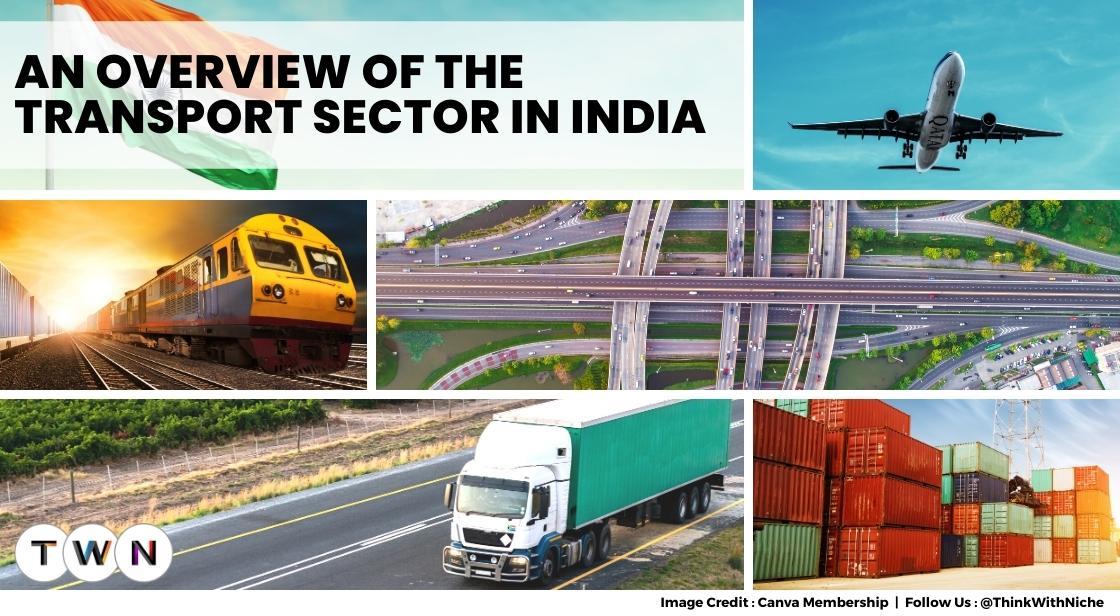An Overview Of Transport Sector In India

Blog Post
The second-largest road transportation network in the world is in India. From one place to another, a transportation system moves both people and things. Machines rule the transportation industry nowadays. Transportation routes or channels serve as the key arteries of our economy.
They act as crucial intermediaries between suppliers and consumers. Because of the well-developed transportation system, people are quite close to one another. In a society that is economically, socially, and culturally varied, they promote people's freedom. Several modes of transportation are included in a transportation network.
A country's capacity for sustaining steady economic growth is greatly influenced by its cohesive and well-coordinated transportation network. India's transportation network is made up of a variety of different modes and services, including airports, airlines, inland waterways, ports, railroads, highways, and road transport.
More than 95% of the nation's traffic is transported by roads and railways, which are the main modes of transportation. The railways and roads would continue to rule the transportation scene in the near future, even though other modes including coastal shipping and inland water transport would play a larger role.
This article will provide An Overview Of Transport Sector In India.
In the past few years, the development of India's transportation infrastructure has accelerated dramatically in all areas, including roads, railroads, and ports. The Indian transportation industry is predicted to expand at a compound annual growth rate of 5.9%, making it the fastest-growing sector of the nation's infrastructure overall.
The Bharatmala project, electrification of railroad tracks, emphasis on high-speed trains, the Sagarmala programme, and active work on e-mobility solutions for clean and affordable population mobility are just a few of the initiatives the government has launched in order to expand and develop the sector across the nation and create a world-class infrastructure.
Also, the primary focus has been on improving the country's logistics infrastructure and intermodal transport links through a successful and beneficial public-private cooperation (PPP). By taking on several projects for the improvement of infrastructure and meeting the sector's financial needs, the private sector has also made a noteworthy contribution to the sector.
With innovative initiatives like the Hybrid Annuity Model (HAM), Toll-Operate-Transfer (TOT) model, improved land acquisition process, the introduction of masala bonds, and Infrastructure Investment Trusts (InvITs), among others, the road sector has attracted private investors. With investment possibilities in areas like the elevated rail route in Mumbai, some of the dedicated freight corridors, freight terminals, station renovations, and power generation and energy-saving initiatives, the Indian Railways has gained traction. The Major Port Authorities Bill, 2016, the Sagarmala programme, and the "Landlord port" model have all played a key role in boosting the Ports & Shipping industry.
In order to meet the goal of selling only electric vehicles by 2030, the government is also collaborating with various automakers and important policy stakeholders. To this end, the government has identified several crucial areas related to transportation mobility where significant policy reforms can be started.
For our nation to be connected and to promote economic progress, a system of intelligent transportation infrastructure is essential. There are many opportunities in areas like roads and highways, high-speed trains, port expansion, and multimodal hubs where private investments and legislative initiatives may play a crucial role in giving the nation a top-notch infrastructure.
An Overview Of Transport Sector In India
India's Transport History
Sher Shah Suri started the road transportation industry in India. He constructed the first road connecting the Indus Valley with Sonar Valley in Bengal and connecting Kabul, Peshawar, Punjab, and Bengal from Afghanistan and Pakistan (India)
In the Ramayana, this highway is known as Uttarapath. Other names for Uttarapath Road include The Long Walk, Sadak-E-Azam, and Shah Rah-E-Azam. Colonials later gave the same road the name Grand Trunk Road.
Now, GT Road is made up of only one road and goes by the same name. Following the partition, it links the road from Amritsar to Calcutta.
Different Types of Transport in India
There are various types of road transportation in India. Four categories can be used to broadly classify transportation systems:
1. Road Transport in India
With a total length of 5.89 million kilometres, India has the second-largest road network in the world (kms). 90% of India's total passenger traffic commutes on the country's road network, which transports 64.5% of all commodities in the nation. As the country's cities, towns, and villages become more connected, road travel has gradually increased throughout time.
The sale of cars and the movement of freight via roadways are expanding quickly in India.
Between FY16 and FY21, highway development in India expanded at a 17.00% CAGR. India built 13,298 km of highways in FY21 despite the pandemic and the lockdown. The Ministry of Road Transport and Highways has received funding from the Indian government of Rs. 199,107.71 crore (US$ 26.04 billion) as part of the Union Budget 2022–23. The Ministry of Road Transport and Highways built 5,835 km of national highways in FY22 (until December). As opposed to 1,681 km in June 2020, the Ministry of Road Transport and Highways built 2,284 km of national highways in June 2021.
In Tripura, the foundation stone was laid in October 2020 for nine National Highway projects totaling 262 km and costing more than Rs. 2752 crore (US$ 371.13 million).
Under the National Infrastructure Pipeline, the Indian government has allotted Rs. 111 lakh crore (US$ 1.4 trillion) for the fiscal years 2019–25. Throughout the fiscal years 2019–25, the roads sector is anticipated to account for 18% of capital expenditures.
The National Investment and Infrastructure Fund (NIIF) will have integrated its road and highway portfolio by October 2020. With the NIIF master fund, the NIIF has purchased the Essel Devanahalli Tollway and the Essel Dichpally Tollway. These road infrastructure projects will be supported by Athaang Infrastructure, the exclusive road network of NIIF, with assistance from a group of seasoned experts with a variety of transport-related specialties.
India's roadways are responsible for 80% of its passenger travel as well as 60% of its freight or cargo transportation. Transportation networks for both public and commercial usage are among them, as are highway buses, highway express services, and others. Due to an increase in road accidents caused by uncontrolled speeds of roadway buses, special buses on Indian roads outfitted with automatic speed enforcement systems are becoming more and more well-liked and attracting the attention of various state governments.
There are many websites that offer Indian road maps with precise India road distances, and some of those sites also have India road distance calculators that help you get a better sense of how far you'll be going. India's state governments are in charge of road transportation, and each state has its own highway inquiry system.
The separate state or union territory governments are responsible for managing and overseeing India's diverse types of transportation as well as its extensive road infrastructure. The National Highways Authority of India (NHAI), which is under the control of the Central Government, is the exception.
India's road map displays five different types of roads, including:
National Highways
State Highways
Major District Roads
Other District Roads
Village Roads
Even though they make up just 2% of India's total road infrastructure, national highways transport more than 40% of all road freight. In India, there are 259 national highways that span more than 52,000 kilometres. The national highways cross all of India's states and link the country's major cities, including New Delhi, Mumbai, Bangalore, Chennai, Pune, Kolkata, Hyderabad, Gurgaon, and others, to more remote locations like Kullu, Shimla, Kangra, Lucknow, Gorakhpur, Bagdogra, Bhopal, Udaipur, Gwalior, Aurangabad, Ranchi, Varanasi, Guwahati, Tirupati, Coimba
2. Rail Transport in India
The Indian railway network is recognized as the backbone and lifeblood of the country's economy. Indian railways are the fourth largest in the world, behind those of the US, China, and Russia, and almost encircle the whole country. The entire infrastructure is under the control of the Railways Board, which in India has exclusive rights to provide rail services. Railways continue to be the most preferred mode of transportation for the majority of Indians when traveling great distances because of its low cost and efficient operations.
One of the largest single-managed railroad networks in the world is India's railway system. In addition to being a cheap and effective means of transportation, the railway network is perfect for long-distance travel and the transit of large commodities. The preferred auto carrier in the nation is Indian Railways.
By implementing laws that are favorable to investors, the Indian government has prioritized investments in rail infrastructure. The process of allowing foreign direct investment (FDI) in the railways to upgrade the infrastructure for freight and high-speed trains has advanced swiftly. Several domestic and international businesses are currently exploring investing in rail projects in India.
The first proposal for a rail system in India was made in 1832, but no more effort was done for more than ten years. Lord Hardinge, the Governor-General of India, permitted private businessmen to establish a rail network in India in 1844. The East India Company was requested to help establish two new railroad companies. Over the following few years, a rail system in the UK was quickly built as a result of investor interest. On December 22, 1851, the first train in India started running, and it was used to transport building supplies through Roorkee. Several years later, on April 16, 1853, the first passenger train between Bori Bunder, Bombay, and Thana, covering a distance of 34 km (21 miles), was officially inaugurated, establishing India's railway system.
The British government promoted the formation of railway companies by private investors through a programme that promised a five percent annual return during the first few years of operation. The original firm would maintain operational control until the project was finished, at which point it would be passed to the government. By 1880, this network had 14,500 km (9,000 miles) of route mileage, primarily extending inward from the three major port cities of Bombay, Madras, and Calcutta. India began producing its own locomotives in 1895 and dispatched engineers and engines to assist in the construction of the Uganda Railways in 1896.
Soon, other separate kingdoms had their own train networks, and the system expanded to the areas that would later become the states of Assam, Rajasthan, and Andhra Pradesh. Although a Railway Board was established in 1901, Lord Curzon, the Viceroy, still officially maintained the power. The Railway Board, which was run by the Department of Commerce and Industry was composed of three people: a government railway official who served as chairman, an English railway manager, and a representative of one of the company railways. The Railways started to turn a healthy profit for the first time in its history. Nearly every train company was taken over by the government in 1907.
With around 22,593 active trains (9141 freight and 13,452 passenger trains), India has the fourth-largest railway network, carrying 24 million passengers daily and 203.88 million tonnes of freight. In FY22, there were 3.54 billion passengers, up from 1.28 billion in FY21. Railway freight traffic totaled 1,400 MT in FY 2021–22. The Indian Railways has operated 450 Kisan Rail services since August 2020 and has been able to deliver more than 1.45 lakh tonnes of agricultural products and perishables. In November 2020, India Railways said that 40% of the dedicated freight corridor (DFC) will be opened for traffic by end-FY21 and that the entire 2,800 km route will be finished by June 2022. RailTel is a PSU under the Railway Ministry that offers quick and cost-free Wi-Fi throughout the As of 2017, India was one of the top 20 countries exporting railroads worldwide. India exported US$ 507,90 million worth of railroad equipment from 2010 to 2018, growing at a CAGR of 31.51%. Railway exports totaled US$ 635 million in 2019E.
With 15,000 km being converted to automatic signalling and 37,000 km to be equipped with "KAVACH," the domestically built Train Collision Avoidance System, Indian Railways is advancing and inventing technology in fields like signalling and telecommunication.
Important highlights of Indian rail transportation
- The passenger segment is expanding as a result of growing urbanisation and rising affluence (in both urban and rural areas).
- By 2050, India is anticipated to represent 40% of all rail activity worldwide.
- With 15,000 km being converted to automatic signalling and 37,000 km to be equipped with "KAVACH," the domestically built Train Collision Avoidance System, Indian Railways is advancing and inventing technology in fields like signalling and telecommunication.
- The government has permitted 100% FDI in the railroad industry.
- A new iron ore policy guiding the distribution of rakes and the transportation of iron ore was released by the Ministry of Railways in January 2021.
3. India's Aviation Industry
Throughout the next ten years, India, which is currently the world's seventh-largest civil aviation industry, is anticipated to overtake the United States as the third-largest civil aviation market. With the highest market share, Indigo is India's biggest airline carrier. India has overtaken the UK to become the third-largest domestic aviation market in the world, and by 2024, it is predicted to surpass the UK to occupy that position.
In the last three years, India's civil aviation sector has become one of the fastest-growing in the nation. It can be broadly divided into three categories: scheduled air transport service, which includes both domestic and international airlines; non-scheduled air transport service, which includes charter operators and air taxi operators; and air cargo service, which includes the air delivery of mail and cargo. In South Asia, domestic travel accounts for over 69% of all airline travel, and by 2023, India's airports will be able to accommodate 1 billion passengers yearly. According to the air traffic movement, which was 613,566 in the first quarter of FY 2022–23 compared to 300,405 in the same period last year, a rise of 104.24%, the Indian aviation industry has fully recovered from the covid-19 pandemic shock.
When air postal service began in 1911 over a brief distance of 10 km between Allahabad and Naini, air travel in India had a modest beginning. In 1929–1930, the British, French, and Dutch introduced air travel.
In 1933, Indian National Airlines was established, and it started operating flights between Lahore and Karachi. Major cities including Karachi, Mumbai, Delhi, Kolkata, Lahore, and several other locations had access to air services by the conclusion of World War II.
There were four businesses at the time of the country's partition in 1947: Tata Sons Ltd./Air India, Indian National Airlines, Air Services of India, and Deccan Airways. By 1951, four further businesses had also been established: Bharat Airways, Himalayan Aviation Ltd., Airways India, and Kalinga Airlines. Following the nationalization of the aviation industry in 1953, the Indian Airlines and Air India International corporations were established.
The Indian aviation industry is evolving and is expected to grow rapidly. There is no denying that air travel has increased in India. Economic liberalization has completely altered the perspective of a potential airline passenger. He no longer considers the benefits and drawbacks of air travel; instead, he now thinks in terms of time.
According to the International Air Transport Association (IATA), India is anticipated to surpass China and the United States as the third-largest air passenger market in the world during the next ten years, by 2030. . Also, the sector's increasing demand has increased the number of aircraft operating there. By 2027, 1,100 planes are anticipated to be in operation worldwide.
In FY 2022–23, India's passenger traffic totaled 150,044,013 passengers (April-September 2022). Airports in India estimate that domestic passenger traffic will reach 166.8 million in FY22, up 58.5% year over year, while international passenger traffic will reach 22.1 million, up 118% year over year.
4. Indian Water Transport:
The most effective and frequently necessary mode of transportation is by water. The most intelligent method for transporting massive, ephemeral, and heavy objects over critical distances is by water. The majority of the time, this venture out approach is used to transport people. the movement of people and goods via boat, boat, barge, or boat across an ocean, an ocean, a lake, a trench, a stream, or using entirely different water transportation methods. It is an essential transportation tactic.
Waterways
The least expensive and hence most seasoned mode of transportation is water transport. It operates on a standard track and as a result, besides in the event of channels, does not require a significant capital investment in the development and maintenance of its track. Midland streams and ocean courses are the two main types of courses. Lakes and safe streams are used as midland streams.
Ports are used to connect ocean channels. Oceanic shipping routes are frequently used to transport goods from one country to the next. Water transport is essential to uncharted trade and has played a significant role in bringing various parts of the world closer together.
Inland Waterways
India has a large network of trenches, brooks, backwaters, and rivers in the middle of the country. When compared to developed countries, the country significantly underutilizes the ability to move goods via streams. inland waterway travel Within the National Waterways, Wing is responsible for improvement, the executives, limit building execution, and institutional reinforcing drives.
Future of India's transportation sector
The future of the Indian transportation sector will be shaped by profound disruptions brought about by intelligent transportation systems powered by Industry 4.0, data analytics, IoT, and artificial intelligence, including hyperloop and remotely operated and autonomous cars.
In its pursuit of cleaner energy and greener low carbon energy fuel, the existing transportation sector will also experience a transformation, with electric mobility, biofuel-driven, and hydrogen-powered vehicles taking a lead. As a result, India would be able to meet its promise to reduce GHG emissions intensity by 33% to 35% below 2005 levels by 2030 and contribute to energy security by lowering reliance on imports. India, a leader in the International Solar Alliance, wants to use solar energy for transportation.
With regard to advanced battery technology, higher energy densities, quicker charging, and lessened battery deterioration from charging, India wants to be competitive on a worldwide scale. By 2030, the government wants to have new sales of cars and two-wheelers comprise 30% electric vehicles. As a result, India's transportation is transitioning to new modes and intelligent energy sources supported by physical and digital infrastructure.
You May Like
EDITOR’S CHOICE












